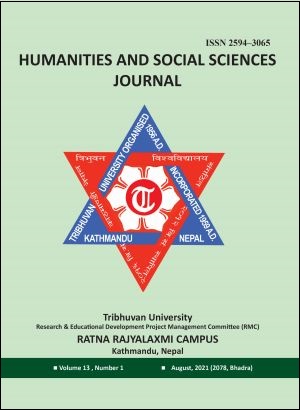‘छोरी ब्रह्माण्ड’का कथामा मानव–रोबोट सम्बन्ध {The human-robot relationship in the story of 'Daughter Universe'}
DOI:
https://doi.org/10.3126/hssj.v13i1.44604Keywords:
जैविक सीमा, कृत्रिम बुद्धिमत्ता, रोबोटAbstract
प्रस्तुत लेखमा सरुभक्तको विज्ञान कथासङ्ग्रह छोरी ब्रह्माण्ड सङ्ग्रहका कथामा अभिव्यञ्जित मानव–रोबोट सम्बन्धको विश्लेषण गरिएको छ । यो लेख छोरी ब्रह्माण्ड सङ्ग्रहका कथामा मानव–रोबोट सम्बन्ध के कस्तो छ भन्ने प्राज्ञिक समस्याको समाधानमा केन्द्रित छ । यसका निम्ति पुस्तकालय कार्यबाट प्राथमिक र द्वितीयक सामग्री सङ्कलन गरिएको छ भने आइज्याक आसिमोभले रोबोट भिजन (सन् १९९०) मा प्रस्तुत गरेका रोबोटसम्बन्धी मान्यतालाई सैद्धान्तिक आधार बनाई (क) सङ्कटापन्न मानव श्रम, (ख) सन्तानेच्छा र रोबोट र (ग) मानवका जैविक सीमा र रोबोट गरी मुख्य तीन पक्षमा आधारित विश्लेषणको ढाँचालाई उपयोग गरिएको छ । यस सङ्ग्रहका कथामा अभिव्यञ्जित मानव–रोबोट सम्बन्धको विश्लेषणबाट भविष्यको समाजमा रोबोट प्रयोगका सकारात्मक सम्भावनासँगै तिनले निम्त्याउन सक्ने जोखिमतर्फ पनि ती कथाले सचेत गराएको निष्कर्ष प्रस्तुत गरिएको छ ।
{In the present article, Sarubhakta's collection of science fiction is expressed in the story of Chhori Brahmand collection the human-robot relationship has been analyzed. This article is in the story of the daughter universe collection the human-robot relationship focuses on solving scientific problems. Its Primary and secondary materials have been collected from library work for Isaac Asimov's Theory of Robotism, presented in Robot Vision (1990) Based on (a) critical human labor, (b) childbearing and robots and (c) human An analysis framework based on three main aspects, including biological boundaries and robots Is From the analysis of the human-robot relationship expressed in the story of this collection to the future Along with the positive possibilities of using robots in the society, they also point out the risks that they can cause The story warns The cautionary conclusion is presented.}




